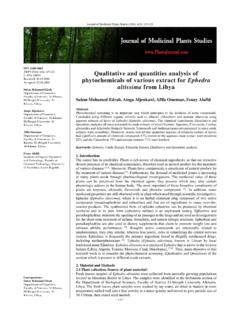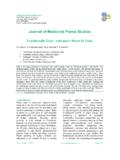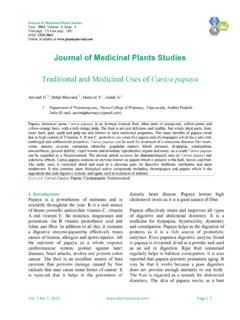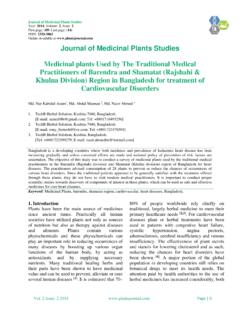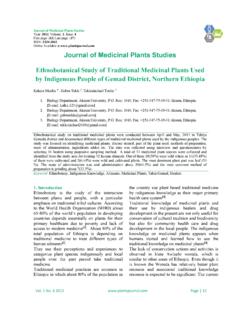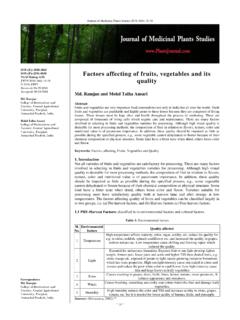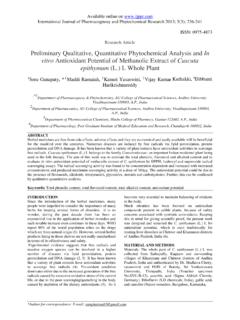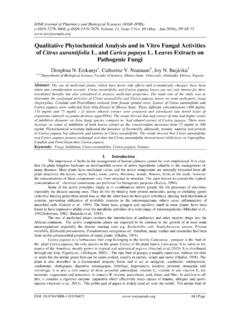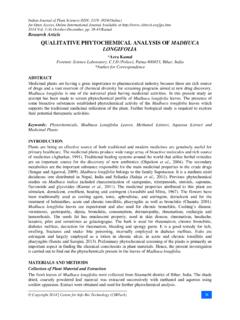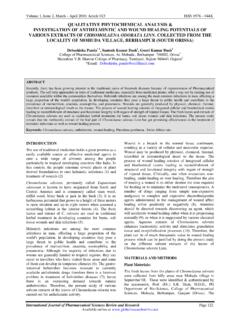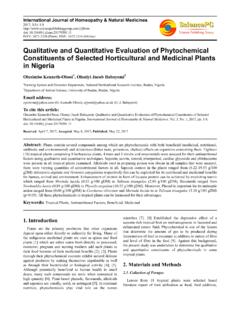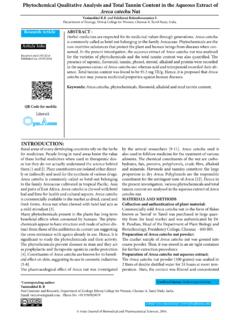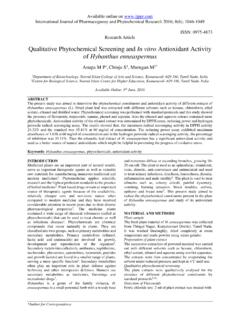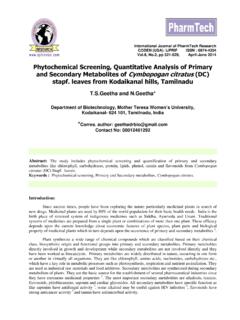Transcription of Qualitative phytochemical analysis of some plants use to ...
1 ~ 60 ~ Journal of Medicinal plants Studies 2015; 3(6): 60-62 ISSN 2320-3862 JMPS 2015; 3(6): 60-62 2015 JMPS Received: 25-09-2015 Accepted: 28-10-2015 Sushant Ram Research Scholar Department of Botany, Tata College, Chaibasa Jharkhand 833202. Vishnu Shankar Sinha Head Department of Botany, Tata College, Chaibasa Jharkhand 833202. Correspondence Sushant Ram Research Scholar Department of Botany, Tata College, Chaibasa Jharkhand 833202. Qualitative phytochemical analysis of some plants use to cure Malaria in Kolhan region, of Jharkhand, India Sushant Ram, Vishnu Shankar Sinha Abstract The present Paper reports the comparative phytochemical analysis of ten medicinal plants , Argemone mexicana L, (Papaveraceae) Boerhavia diffusa L (Nyctaginaceae) Cassia tora L, Cassia fistula L (Caesalpiniaceae), Catharanthus roseus L (Apocynaceae), Jatropha gossypiifolia L (Euphorbiaceae), Nyctanthes arbor tristis L.
2 (Oleaceae), Ocimum basilicum L (Labiateae), Phyllanthus nirui L (Euphorbiaceae) and Sida rhombifolia L (Malvaceae) which are used for the treatment of Malaria by the people of Kolhan region of Jharkhand India. Plant leaves were air dried for one week in shade and were grinded to make powder for the preparation of plant leaves extract. Powders were soaked in 97% Ethanol and Methanol solution for 72 hours at room temperature, after that extracts were evaporated and then plant leaves extract was obtained. The present phytochemical analysis confirms the presence of Alkaloids, Flavonoids, Saponins, Phenols, Carbohydrates, Tannins, Steroids and Glycosides in plants leaves solutions.
3 The Alkaloids was tested by Wagner s test, Glycosides by NaOH solution, Tannins by the help of FeCl2 and Fe2SO4 solution, Flavonoids was detected by the help of HCl and ZnCl2, while the presence of Saponins was confirmed by NaHCO3, Steroids was detected by the help of Acetic acid and H2SO4, Ferric Chloride test was adopted for the detection of phenol whereas presence of Carbohydrate was done by Benedict test. It was interesting to note that Steroids was present in all leaf extract except Catharanthus roseus L. Keywords: phytochemical analysis , Plant extracts, Malaria, Kolhan Region etc. Introduction The medicinal plants have contributed immensely for primary healthcare to humans and animals since ancient times, due to failure of some synthetic drugs and its side effect have permuted many researchers to go back to ancient heeling methods which use herbal medicines to give relief and the efficacy of many conventional medicines which ones had near universal effectiveness against serious infection in on the wane.
4 (Sandhya s et al. 2010) [8]. Valiathan (1998) has reported that herbal drugs have effectiveness, minimum side effects, easily available, eco - friendly and relatively low cost. Several top selling drugs of modern times such as Quinine, Artemesinine, Shikonin etc. are obtained from plants where quinine is specially used to cure Malaria (Hidayatulla et al. 2011) [10]. WHO (1983) reported that 80% people worldwide rely on plant based medicines for their primary health care. The human life is intricately linked with the species of plants for food, clothes, building, medicine, oxygen, and recreation etc.
5 The Medicinal plants have curative properties due to the presence of various complex chemical substances of different composition present as secondary metabolisms in one or more parts of these plants . In most of the Phytochemicals secondary metabolites of plant are physiologically active (Shihasudeen et al. 2010) [9]. Materials and Methods Collection of plants : The plants Argemone Mexicana L, Boerhavia diffusa L, Cassia tora L, Cassia fistula L, Catharanthus roseus L, Jatropha gossypiifolia L, Nyctanthes arbor tristis L, Ocimum basilicum L, Phyllanthus nirui L and Sida rhombifolia L. were Collected from Kolhan region, Jharkhand and it has been identified with the help of many referred books like A Hand Book of medicinal plant (Narayan Das Prajapati, Purohit, Arun K.)
6 Sharma Tarun kumar, 2003), [3] Botany of Bihar and Orissa ( Haines 1921), [2] Indian medicinal plants ( Kirtikar and Basu 1918). ~ 61 ~ Journal of Medicinal plants Studies The voucher specimen had been submitted in Department of Botany, Tata College, Chaibasa NO. VSM/BOT 101, 102, 103, 104, 105, 106, 107, 108, 109, 110. Preparation of plant Extract: The collected plant leaves materials were dried in shade and grind in a grinder with a 2mm diameter mesh. The dried and powered plant materials (100g) were extracted successfully using 500 ml of methanol and ethanol (1:5w/v) by using soxhlet extractor for 24 hrs at a temperature not exceeding the boiling point of the solvent.
7 The extract was filtered by using whatman filter paper I and then concentrated in vacuo at 40 0C using a rotary evaporator. The residues obtained were stored in dark glass bottles at -20 0C in air tight containers for further tests. Methods used for phytochemical analysis 1. Test for Alkaloids: (Wagner's test: Iodine- Potassium iodide solution) gm of Iodine and 2gm of H2SO4 and the solution was diluted to 100ml. 10ml of alcoholic extract was acidified by adding v/v of HCl and a few drops of Wagner s reagent. Formation of yellow or brown precipitate confirmed the presence of alkaloids. 2. Test for Glycosides: A small amount of alcoholic extract was dissolved in 1ml of water and the aqueous NaOH solution was dissolved in 1ml of water and the aqueous NaOH solution was added.
8 Formation of yellow color indicates the presence of glycosides. 3. Test for Tannins: (Ferric chloride test) 1-2 ml of aqueous extract few drops of 5% aqueous FeCl2 solution was added. A bluish black color which disappears on addition of a few ml of, H2SO4 there is no formation of the yellow brown precipitate confirms the presence of tannins. 4. Test for Flavonoids: In a test tube containing of alcoholic extract, 5-10 drops of dilute HCl and small piece of ZnCl or magnesium were added and the solution was boiled for a few minutes. In the presence of Flavonoids, reddish pink or dirty brown color was produced. 5. Test for Saponins: In a test tube containing of aqueous extract a drop of sodium bicarbonate was added.
9 The mixture was shaken vigorously and kept for 30 minutes. A honey comb like froth was formed and it showed the presence of Saponins. 6 Test for Steroids: (Salkowski test) 2ml of chloroform extract, 1ml of concentrated H2SO4 acid was added carefully along the sides of the test tubes. A red color was produced in the chloroform layer and confirms the presence of steroids. 7. Test for Phenols: (Ferric chloride test) 10ml of alcoholic solution of extract, 2ml of distilled water followed by drops of 10% aqueous FeCl3 solution were added. Formation of blue or green indicates the presence of phenols 8. Test for Carbohydrates: (Benedict test and Iodine test) few drops of Benedict solution was added in the plant extract if it shows the brick read color Confirms the presence of glucose and few drops of Iodine was added in other extract the dark blue color confirms the presence of starch.
10 Results and Discussion Table 1: Qualitative phytochemical Constituents of ten medicinal plants studied. TESTS Argemone mexicana L Boerhavia diffusa L Cassia tora L Cassia fistula L Catharanthus roseus L Jatropha gossypiifolia L Nyctanthes arbor tristis L Ocimum basilicum L Phyllanthus nirui L Sida rhombifolia L M E M E ME ME M E M E M E M E M E M E 01 Alkaloids + + + - + + - + - + + + + - ++ + + + + 02 Glycosides + - - + + + + + + - + + - + ++ + +
